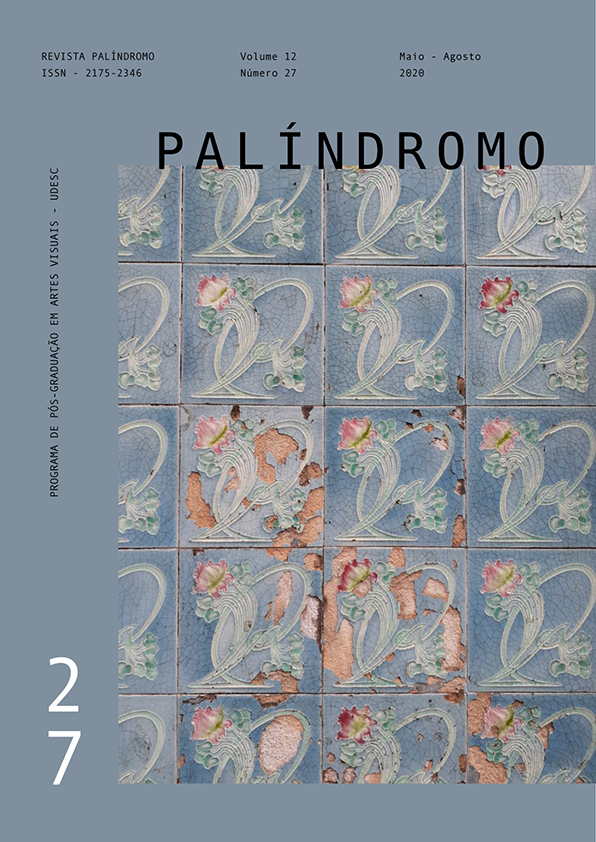Do ornamento ao design total: um panorama histórico a partir de Hal Foster
DOI:
https://doi.org/10.5965/2175234612272020056Parole chiave:
Hal Foster, Ornamento, Design Total, Art NouveauAbstract
Este artigo retoma o polêmico texto “Design e crime”, de Hal Foster, para delinear um breve panorama histórico acerca das relações entre a ornamentação do Art Nouveau e o que o autor denomina “design total”. Para tanto, revisito o debate oitocentista em torno do ornamento e explico como o culto à personalidade emerge com a ornamentação da vida pública. A partir disso, sustento que a difusão do design na vida contemporânea está atrelada a uma conduta do “designer de si”. Assinalo, por fim, a atualidade da provocação de Foster, indicando que, na contramão das narrativas que expõem o design como superação do ornamento, o design segue operando em larga medida à guisa de uma racionalidade ornamental.
Downloads
Riferimenti bibliografici
BAUDRILLARD, J. Para uma crítica da economia política do signo. Rio de Janeiro: Elfos, 1995.
BROWN, W. Nas ruínas do neoliberalismo: A ascensão da política antidemocrática no Ocidente. São Paulo: Politeia, 2019.
COSTA, J. F. O vestígio e a aura: corpo e consumismo na moral do espetáculo. Rio de Janeiro: Garamond, 2005.
DARDOT, P.; LAVAL, C. A nova razão do mundo: ensaio sobre a sociedade neoliberal. São Paulo: Boitempo, 2016.
DELEUZE, G.; GUATTARI, F. O anti-Édipo: capitalismo e esquizofrenia. São Paulo: Editora 34, 2010.
FLUSSER, V. O mundo codificado: Por uma filosofia do design e da comunicação. São Paulo: Cosac & Naify, 2013.
FOSTER, H. Design e crime. ARS (São Paulo), v. 9, n. 18, p. 48-59, 2011.
____. O retorno do real: A vanguarda no final do século XX. São Paulo: Cosac Naify, 2014.
FOUCAULT, M. Nascimento da biopolítica: curso dado no Collège de France (1978-1979). São Paulo: Martins Fontes, 2008.
____. “As técnicas de si”. In: ____. Ditos e Escritos Vol. IX: Genealogia da Ética, Subjetividade e Sexualidade. Rio de Janeiro: Forense Universitária, 2014.
GROYS, B. Self-design and aesthetic resposibility. E-Flux, ed. 7, p. 1-8, 2009. Disponível em: http://worker01.e-flux.com/pdf/article_68.pdf. Acesso em 22 dez. 2019.
JONES, O. A gramática do ornamento: ilustrado com exemplos de diversos estilos de ornamento. São Paulo: SENAC, 2010.
LATOUR, B. Um Prometeu cauteloso? alguns passos rumo a uma filosofia do design (com especial atenção a Peter Slotedijk). Agitprop: revista brasileira de design, São Paulo, v. 6, n. 58, jul./ago. 2014.
LOOS, A. Ornamento e crime. Lisboa: Cotovia, 2004.
MARX, K. Grundrisse. São Paulo: Boitempo, 2011.
NIETZSCHE, F. A gaia ciência. São Paulo: Companhia das Letras, 2012.
PAIM, G. A Beleza sob Suspeita: o ornamento em Ruskin, Lloyd Wright, Loos, Le Corbusier e outros. Rio de Janeiro: Jorge Zahar, 2000.
PODRO, M. The Critical Historians of Art. New Haven: Yale University Press, 1982.
RIEGL, A. Problemas de estilo: Fundamentos para una historia de la ornamentación. Barcelona: Gustavo Gili, 1980.
RUSKIN, J. The Stones of Venice – Volume I: The Foundations. New York: Cosimo, 2007.
SENNETT, R. O declínio do homem público: as tiranias da intimidade. Rio de Janeiro: Record, 2014.
SMILES, S. Self-help: With Illustrations of Character and Conduct. Boston: Ticknor and Fields, 1863. Disponível em: <https://archive.org/details/selfhelpwithill00smilgoog/page/n5>. Acesso em 22 dez. 2019.
WORRINGER, W. Abstraction and Empathy: A Contribution to the Psychology of Style. Chicago: Ivan R. Dee, 1997.
Downloads
Pubblicato
Come citare
Fascicolo
Sezione
Licenza
Copyright (c) 2020 Marcos Namba Beccari

TQuesto lavoro è fornito con la licenza Creative Commons Attribuzione 4.0 Internazionale.
DECLARAÇÃO DE DIREITOS AUTORAIS
a. Os artigos publicados pela revista são de uso gratuito, destinados a aplicações acadêmicas e não comerciais. Todos os direitos autorais são atribuídos à revista. Os artigos cujos autores são identificados representam a expressão do ponto de vista de seus autores e não a posição oficial da Revista Palíndromo. O (s) autor (es) compromete-se sempre que publicar material referente ao artigo publicado no Palíndromo mencionar esta publicação da seguinte forma:
Este artigo foi publicado originalmente pela revista Palíndromo em seu volume (coloque o volume), número (coloque o número) no ano de (coloque o ano) e pode ser acessado em: http://www.revistas.udesc.br/index.php/palindromo
b. Plágio, em todas as suas formas, constitui um comportamento antiético de publicação e é inaceitável. A revista Palíndromo utiliza o software iThenticate de controle de similaridade


